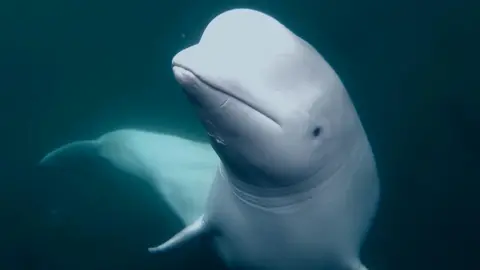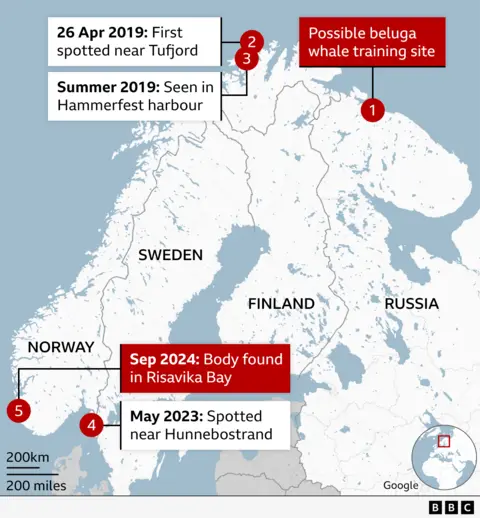
 Norwegian Orca Survey
Norwegian Orca Survey
The tame beluga whale approached Norwegian fishermen in 2019, wearing a harness, leading to speculation that it was an escaped Russian "spy whale"
The mystery as to why a beluga whale appeared off the coast of Norway wearing a harness may finally have been solved.
The tame white whale, which locals named Hvaldimir, made headlines five years ago amidst widespread speculation that it was a Russian spy.
Now an expert in the species says she believes the whale did indeed belong to the military and escaped from a naval base in the Arctic Circle.
But Dr Olga Shpak does not believe it was a spy. She believes the beluga was being trained to guard the base and fled because it was a "hooligan".
Russia has always refused to confirm or deny that the beluga whale was trained by its military.
But Dr Shpak, who worked in Russia researching marine mammals from the 1990s until she returned to her native Ukraine in 2022, told BBC News: “For me it’s 100% (certain).”
Dr Shpak, whose account is based on conversations with friends and former colleagues in Russia, features in a BBC documentary, Secrets of the Spy Whale, which is now on BBC iPlayer and being shown on BBC Two on Wednesday at 21:00 GMT.

 Jørgen Ree Wiiig
Jørgen Ree Wiiig
The beluga whale was wearing a harness which contained a mount for a camera
The mysterious whale first came to public attention five years ago when it approached fishermen off the northern coast of Norway.
“The whale starts rubbing against the boat,” Joar Hesten, one of the fishermen, says. “I heard about animals in distress that instinctively knew that they need help from humans. I was thinking that this is one smart whale.”
The sighting was unusual because the beluga was so tame and they're rarely seen as far south. It was also wearing a harness, which had a mount for a camera, and bore the words, in English, “Equipment St Petersburg”.
Mr Hesten helped to remove the harness from the whale, which then swam to the nearby port of Hammerfest, where it lived for several months.

 Oxford Scientific Films
Oxford Scientific Films
The harness the beluga was wearing had the words "Equipment St Petersburg" on it.
Seemingly unable to catch live fish to eat, it charmed visitors by nudging at their cameras and even on one occasion returning a mobile phone.
“It was very obvious that this particular whale had been conditioned to be putting his nose on anything that looked like a target because he was doing it each time,” says Eve Jourdain, a researcher from the Norwegian Orca Survey.
“But we have no idea what kind of facility he was in, so we don’t know what he was trained for.”
Captivated by the whale's story Norway made arrangements for the beluga to be monitored and fed. The name it was given – Hvaldimir - is a nod to hval which is Norwegian for whale, and the name of Russia's President, Vladimir Putin.

 Oxford Scientific Films
Oxford Scientific Films
Dr Shpak says she is certain the beluga escaped from the Russian military programme but is not convinced it was a spy
Dr Shpak did not want to name her sources in Russia for their own safety but said she had been told that when the beluga surfaced in Norway, the Russian marine mammal community immediately identified it as one of theirs.
“Through the chain of vets and trainers the message came back – that they were missing a beluga called Andruha,” she says.
According to Dr Shpak, Andruha/Hvaldimir had first been captured in 2013 in the Sea of Okhotsk in Russia's Far East. A year later it was moved from a facility owned by a dolphinarium in St Petersburg to the military programme in the Russian Arctic, where his trainers and vets remained in contact.
“I believe that when they started to work in open water, trusting this animal (not to swim away), the animal just gave up on them,” she says.
“What I've heard from the guys at the commercial dolphinarium who used to have him was that Andruha was smart, so a good choice to be trained. But at the same time, he was kind of like a hooligan - an active beluga - so they were not surprised that he gave up on (following) the boat and went where he wanted to.”

 Google
Google
Satellite images from near Murmansk in the Russian Arctic show what appear to be white whales in pens near a submarine base
Satellite images from near the Russian naval base in Murmansk show what could have been Hvaldimir/Andruha’s old home. Pens can clearly be seen in the water with what appear to be white whales inside.
“The location of the beluga whales very close to the submarines and the surface vessels might tell us that they are actually part of a guarding system,” says Thomas Nilsen, from Norwegian online newspaper The Barents Observer.
Russia, for its part, has never officially addressed the claim that Hvaldimir/Andruha was trained by its army. But it does have a long history of training marine mammals for military purposes.
Speaking in 2019, a Russian reserve colonel, Viktor Baranets, said: "If we were using this animal for spying, do you really think we'd attach a mobile phone number with the message 'Please call this number'?"


The beluga whale travelled south over several years
Sadly, Hvaldimir/Andruha’s incredible story does not have a happy ending.
Having learned to feed himself, it spent several years travelling south along Norway’s coast and in May 2023 was even spotted off the coast of Sweden.
Then on September 1 2024 its body was found floating at sea, near the town of Risavika, on Norway's south-western coast.
Had the long arm of Putin’s Russia caught up with the reluctant beluga?
It appears not. Despite some activist groups suggesting that the whale had been shot, that explanation has been dismissed by the Norwegian police.
They say there was nothing to suggest that human activity directly caused the beluga’s death. A post-mortem examination revealed that Hvaldimir/Andruha died after a stick became lodged in his mouth.

 1 month ago
6
1 month ago
6















 English (US) ·
English (US) ·